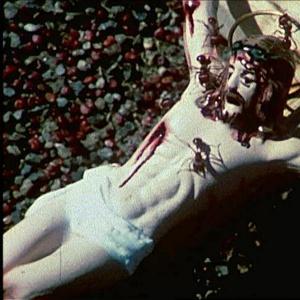
Anty-Christ: Just in time for Christmas, the Brooklyn Museum features a tiresome work that has insects crawling over a Jesus figurine.
NEW YORK POST
November 18, 2011
A boring blasphemy
B’klyn Museum’s shock schlock
by James Panero
Why wait for Black Friday to begin the tedious “War on Christmas”? The Brooklyn Museum has already begun the annual attack on Christian sensibilities in the name of free speech with its “controversial” exhibition, “Hide/Seek: Difference and Desire in American Portraiture.”
The show features a video called “Fire in my Belly,” in which ants crawl over a bloody crucifix. The Catholic Diocese of Brooklyn has already asked that the video be removed from view.
The museum has fallen back on good old “shock art” in a bid to boost something almost as shopworn: its own moral superiority.
It doesn’t have much else to offer. It lost 35 percent of its endowment — $35 million — by gambling on the stock market in 2008; the museum’s director, Arnold Lehman, even went running to the city for a handout.
Even the critics have been panning the museum for years. There’s the garish and expensive new glass entry hall protruding onto Eastern Parkway. There’s the downmarket exhibition program — the art of “Star Wars” — which has done nothing to boost attendance. There’s its disconnection from the burgeoning contemporary art scene in the borough — a fact the museum has only begun to address.
But rather than put in the hard work to make the institution truly responsive to the people of Brooklyn, the museum has decided to party like it’s 1999 — when it made international headlines and earned the accolades of its peers by going toe to toe with Mayor Rudy Giuliani over its “Sensation” show, which featured a painting of the Virgin Mary made of elephant dung and pornographic photos.
After a similar controversy erupted late last year in Washington, DC, when Hide/Seek” premiered at the National Portrait Gallery, the Brooklyn Museum pounced.
Cynical? Sure. Hardly anyone took notice of the show or its video by the AIDS activist David Wojnarowicz until the Smithsonian (a government-funded institution like the Brooklyn Museum) removed it from view after complaints from Christian groups.
“It was entirely predictable that the right would try to bash the show for their own agenda,” Jonathan Katz, one of the show’s curators, later proclaimed. (He’s now a big ticket on the lecture circuit.) “The Catholic League and other radical conservative groups — they’re parasites that feed off controversy. That’s how they make money. I knew that and so did the Smithsonian.”
Parasites that feed off controversy? Liberal tastemakers are the ones who have taken this controversy to the bank. As the cry of censorship went up between Washington and New York, only then did “Fire in my Belly,” an artistically insignificant work, became a hot item. The Museum of Modern Art bought it for its permanent collection, the New Museum put it on display in its lobby and the artist’s New York gallery started promoting the work like crazy.
Now Arnold Lehman has snagged the entire exhibition for an outerborough run. Of course, he hopes the controversy will come to town, too: Nothing sells liberal superiority better than the free publicity of a Christian backlash.
That’s true even if you are a public institution trying to enrage part of your constituency to sell yourself to another.
Readers responses here.
Hi Charlie.
